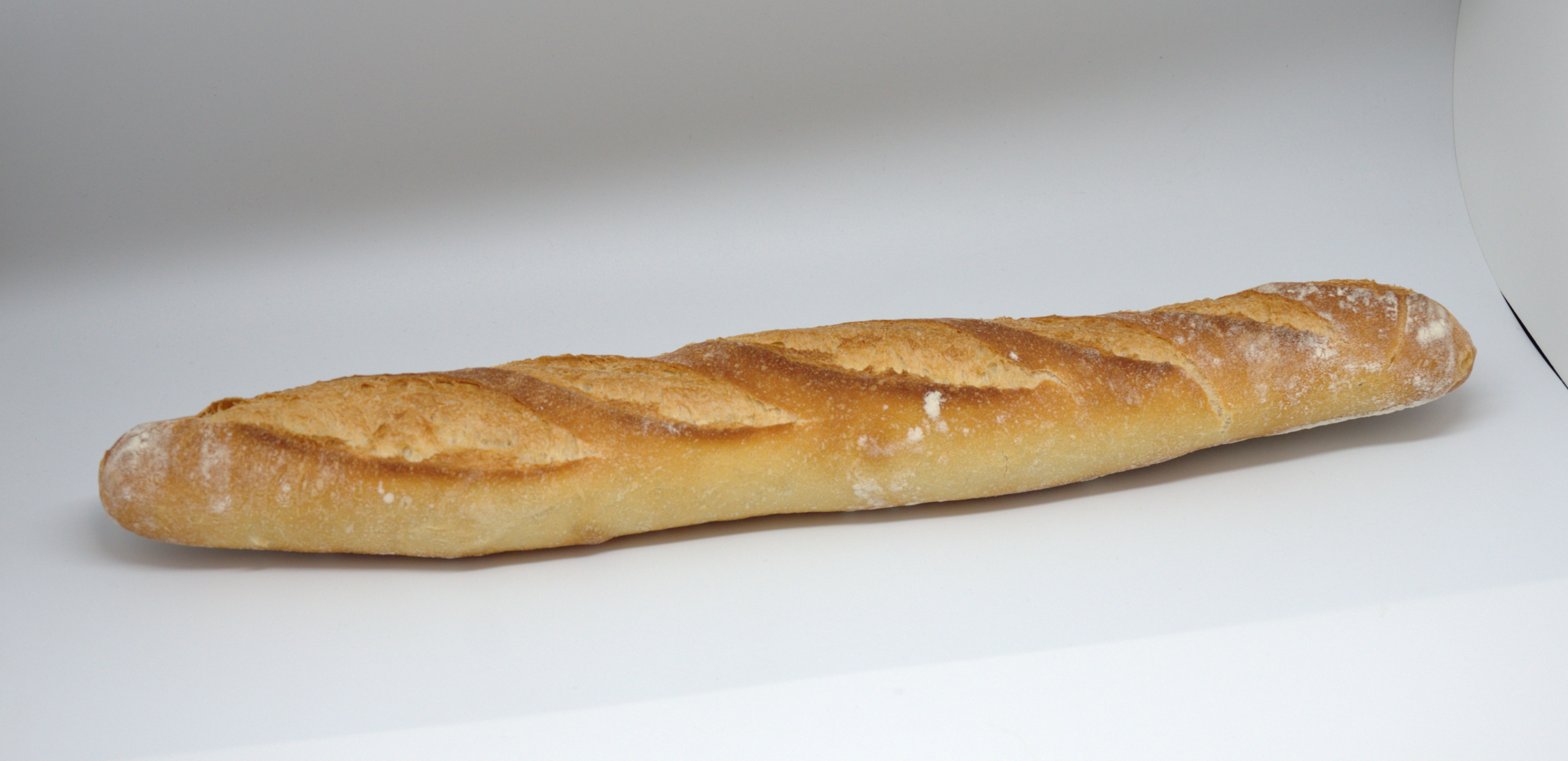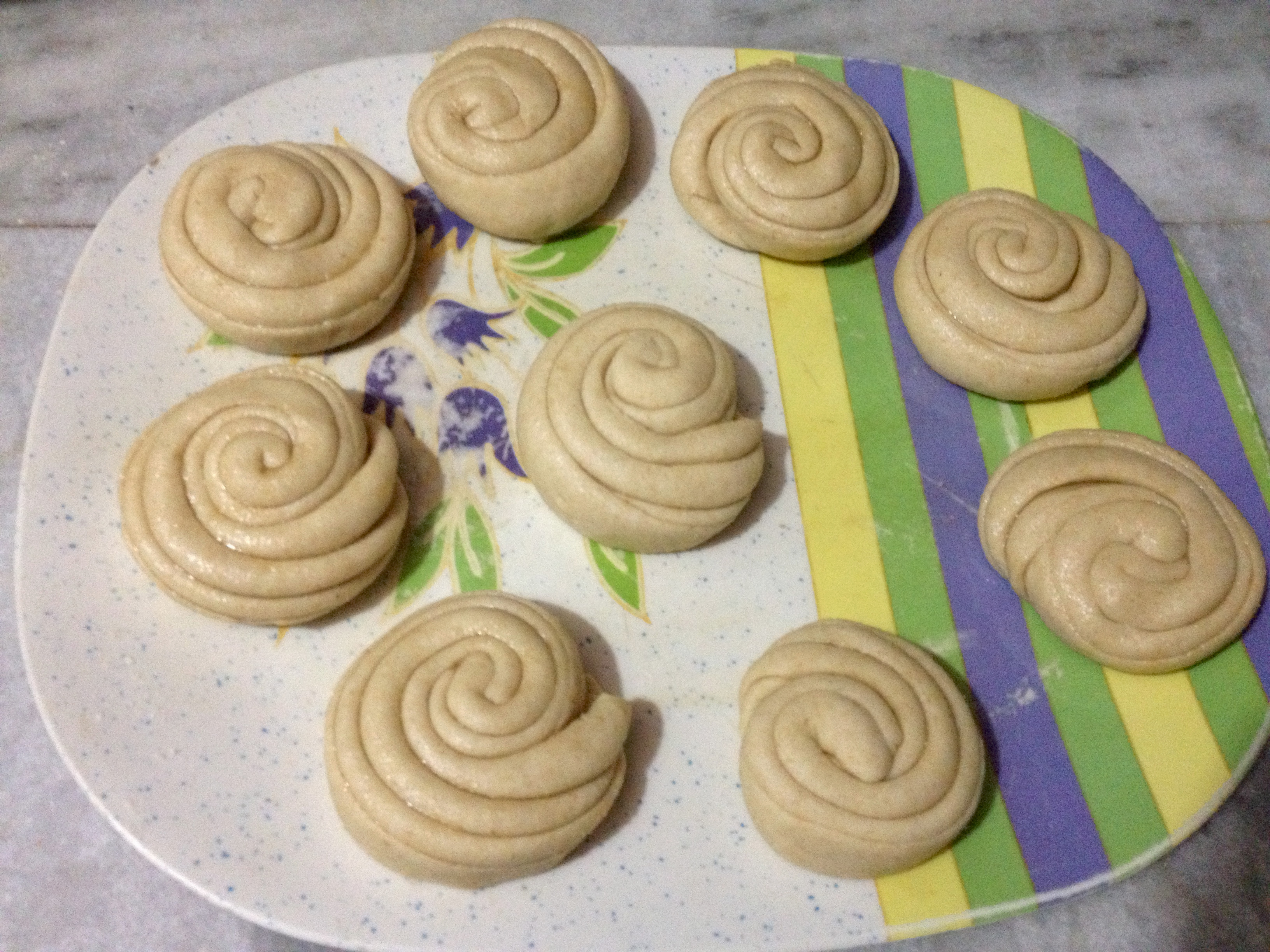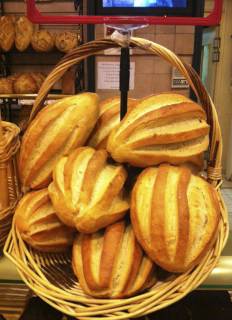|
List Of French Breads
This is a list of notable French breads, consisting of breads that originated in France. * Baguette – a long, thin type of bread of French origin. The "baguette de tradition française" is made from wheat flour, water, yeast, and common salt. It may contain up to 2% broad bean flour, up to 0.5% soya flour, and up to 0.3% wheat malt flour. * Boule de pain – a traditional shape of French bread resembling a squashed ball. It is traditionally prepared using only bread flour, salt, a leavening agent and water. * Brioche – has a high egg and butter content, which gives it a rich, tender and tight crumb. * Croissant – a buttery, flaky, French viennoiserie pastry inspired by the shape of the Austrian kipferl but using the French yeast-leavened laminated dough. Croissants are named for their historical crescent shape, the dough is layered with butter, rolled and folded several times in succession, then rolled into a thin sheet, in a technique called laminating. The p ... [...More Info...] [...Related Items...] OR: [Wikipedia] [Google] [Baidu] |
Baguette2
A baguette (; ) is a long, thin type of bread of French origin that is commonly made from basic lean dough (the dough, though not the shape, is defined by French law). It is distinguishable by its length and crisp crust. A baguette has a diameter of about and a usual length of about , although a baguette can be up to long. In November 2018, documentation surrounding the "craftsmanship and culture" of making this bread was added to the French Ministry of Culture's National Inventory of Intangible Cultural Heritage. In 2022, the artisanal know-how and culture of baguette bread was inscribed to the UNESCO Intangible Cultural Heritage Lists. History Much of the history of the baguette is speculation; however, some facts can be established. Long, stick-like breads in France became more popular during the 18th century, French bakers started using " ''gruau''," a highly refined Hungarian high-milled flour in the early 19th century, Viennese steam oven baking was introduced to P ... [...More Info...] [...Related Items...] OR: [Wikipedia] [Google] [Baidu] |
Faluche (bread)
Faluche is a traditional bread in the Nord-Pas-de-Calais region of northern France and the Tournai region of southern Belgium. Faluche is a pale white bread that is soft and fairly dense. It is neither a round nor flat bread but looks somewhat like a small deflated soccer ball. It may be eaten hot at breakfast with butter and jam or with cream cheese and smoked salmon or later as a snack with butter and brown sugar or with brie cheese. Faluche is made with white flour Flour is a powder made by grinding raw grains, roots, beans, nuts, or seeds. Flours are used to make many different foods. Cereal flour, particularly wheat flour, is the main ingredient of bread, which is a staple food for many culture ..., baker's yeast, water, a little salt and butter. In a bakery, faluche was often baked as the oven was just heating up before the main baking. References External links * The entry to Faluche (pain) in the French Wikipedia {{French bread French breads Be ... [...More Info...] [...Related Items...] OR: [Wikipedia] [Google] [Baidu] |
Pain Complet
Pain is a distressing feeling often caused by intense or damaging stimuli. The International Association for the Study of Pain defines pain as "an unpleasant sensory and emotional experience associated with, or resembling that associated with, actual or potential tissue damage." In medical diagnosis, pain is regarded as a symptom of an underlying condition. Pain motivates the individual to withdraw from damaging situations, to protect a damaged body part while it heals, and to avoid similar experiences in the future. Most pain resolves once the noxious stimulus is removed and the body has healed, but it may persist despite removal of the stimulus and apparent healing of the body. Sometimes pain arises in the absence of any detectable stimulus, damage or disease. Pain is the most common reason for physician consultation in most developed countries. It is a major symptom in many medical conditions, and can interfere with a person's quality of life and general functioning. Simp ... [...More Info...] [...Related Items...] OR: [Wikipedia] [Google] [Baidu] |
Brier
Briar, Briars, Brier, or Briers may refer to: * Briar, or brier, common name for a number of unrelated thorny plants that form thicket People * Brier (surname) * Briers, a surname * Briars (surname) Places * Briar, Missouri, U.S. * Briar, Texas, U.S. * Briars Historic Park, Mount Martha, Victoria, Australia * The Briars (Georgina), Ontario, Canada, a lakeside resort * Brier, Washington, U.S. * Briers, Mississippi, , U.S., a ghost town * Brier Island, Nova Scotia, Canada * Briar Creek (other), or Brier Creek * Briar Hill (other) * Brier Hill (other) Buildings * Briars, Saint Helena, a small pavilion in which Napoleon Bonaparte stayed * The Briars (Natchez, Mississippi), U.S., a historic house * The Briars, Wahroonga, Sydney, Australia, a historic house Fictional characters * Briar Moss, from Tamora Pierce's ''Circle of Magic'' and ''Circle Opens'' quartets * Briar Cudgeon, in ''Artemis Fowl'' * Briar, the evil sister of Rose in B ... [...More Info...] [...Related Items...] OR: [Wikipedia] [Google] [Baidu] |
Old Norman
Old Norman, also called Old Northern French or Old Norman French ( fro, Ancien Normant, nrf, Ancien Normaund), was one of many varieties of the '' langues d'oïl'' native to northern France. It was spoken throughout the region of what is now called Normandy and spread into England, Southern Italy, Sicily and the Levant. It is the ancestor of modern Norman, including the insular dialects (such as Jèrriais), as well as Anglo-Norman. Old Norman was an important language of the Principality of Antioch during Crusader rule in the Levant. Old Norman contained Old Norse loanwords unknown in other Old French dialects at that time. Writings of the Jersey-born poet Wace Wace ( 1110 – after 1174), sometimes referred to as Robert Wace, was a Medieval Norman poet, who was born in Jersey and brought up in mainland Normandy (he tells us in the ''Roman de Rou'' that he was taken as a child to Caen), ending his car ... are among the few records of Old Norman that remain. References ... [...More Info...] [...Related Items...] OR: [Wikipedia] [Google] [Baidu] |
Dough
Dough is a thick, malleable, sometimes elastic paste made from grains or from leguminous or chestnut crops. Dough is typically made by mixing flour with a small amount of water or other liquid and sometimes includes yeast or other leavening agents, as well as ingredients such as fats or flavorings. Making and shaping dough begins the preparation of a wide variety of foodstuffs, particularly breads and bread-based items, but also including biscuits, cakes, cookies, dumplings, flatbreads, noodles, pasta, pastry, pizza, piecrusts, and similar items. Dough can be made from a wide variety of flour, commonly wheat and rye but also maize, rice, legumes, almonds, and other cereals or crops. Types of dough Doughs vary widely depending on ingredients, the desired end product, the leavening agent (particularly whether the dough is based on yeast or not), how the dough is mixed (whether quickly mixed or kneaded and left to rise), and cooking or baking technique. There is no formal ... [...More Info...] [...Related Items...] OR: [Wikipedia] [Google] [Baidu] |
Normandy
Normandy (; french: link=no, Normandie ; nrf, Normaundie, Nouormandie ; from Old French , plural of ''Normant'', originally from the word for "northman" in several Scandinavian languages) is a geographical and cultural region in Northwestern Europe, roughly coextensive with the historical Duchy of Normandy. Normandy comprises mainland Normandy (a part of France) and the Channel Islands (mostly the British Crown Dependencies). It covers . Its population is 3,499,280. The inhabitants of Normandy are known as Normans, and the region is the historic homeland of the Norman language. Large settlements include Rouen, Caen, Le Havre and Cherbourg. The cultural region of Normandy is roughly similar to the historical Duchy of Normandy, which includes small areas now part of the departments of Mayenne and Sarthe. The Channel Islands (French: ''Îles Anglo-Normandes'') are also historically part of Normandy; they cover and comprise two bailiwicks: Guernsey and Jersey, which are B ... [...More Info...] [...Related Items...] OR: [Wikipedia] [Google] [Baidu] |
Pain Brié
Pain brié is a traditional Normandy bread Bread is a staple food prepared from a dough of flour (usually wheat) and water, usually by baking. Throughout recorded history and around the world, it has been an important part of many cultures' diet. It is one of the oldest human-made f .... Its name comes from the pounding of the dough, as "brie" is derived from the Old Norman verb '' brier'', meaning "to pound". The preparation includes a long kneading period and a beating of the dough, which tightens it, producing a heavy, yeasted bread with a tight crumb. It used to be the bread given to fishermen and sailors. References *''The Concise Larousse Gastronomique: The World's Greatest Cookery Encyclopedia'', Prosper Montagne, 2003. p169. *''The Breads of France: And How to Bake Them in Your Own Kitchen'', Bernard Clayton, 2002. p88. French breads Yeast breads {{bread-stub ... [...More Info...] [...Related Items...] OR: [Wikipedia] [Google] [Baidu] |
Pain Aux Noix
Pain is a distressing feeling often caused by intense or damaging stimuli. The International Association for the Study of Pain defines pain as "an unpleasant sensory and emotional experience associated with, or resembling that associated with, actual or potential tissue damage." In medical diagnosis, pain is regarded as a symptom of an underlying condition. Pain motivates the individual to withdraw from damaging situations, to protect a damaged body part while it heals, and to avoid similar experiences in the future. Most pain resolves once the noxious stimulus is removed and the body has healed, but it may persist despite removal of the stimulus and apparent healing of the body. Sometimes pain arises in the absence of any detectable stimulus, damage or disease. Pain is the most common reason for physician consultation in most developed countries. It is a major symptom in many medical conditions, and can interfere with a person's quality of life and general functioning. Simp ... [...More Info...] [...Related Items...] OR: [Wikipedia] [Google] [Baidu] |
Wheat
Wheat is a grass widely cultivated for its seed, a cereal grain that is a worldwide staple food. The many species of wheat together make up the genus ''Triticum'' ; the most widely grown is common wheat (''T. aestivum''). The archaeological record suggests that wheat was first cultivated in the regions of the Fertile Crescent around 9600 BCE. Botanically, the wheat kernel is a type of fruit called a caryopsis. Wheat is grown on more land area than any other food crop (, 2014). World trade in wheat is greater than for all other crops combined. In 2020, world production of wheat was , making it the second most-produced cereal after maize. Since 1960, world production of wheat and other grain crops has tripled and is expected to grow further through the middle of the 21st century. Global demand for wheat is increasing due to the unique viscoelastic and adhesive properties of gluten proteins, which facilitate the production of processed foods, whose consumption is inc ... [...More Info...] [...Related Items...] OR: [Wikipedia] [Google] [Baidu] |
Provence
Provence (, , , , ; oc, Provença or ''Prouvènço'' , ) is a geographical region and historical province of southeastern France, which extends from the left bank of the lower Rhône to the west to the Italian border to the east; it is bordered by the Mediterranean Sea to the south. It largely corresponds with the modern administrative region of Provence-Alpes-Côte d'Azur and includes the departments of Var, Bouches-du-Rhône, Alpes-de-Haute-Provence, as well as parts of Alpes-Maritimes and Vaucluse.''Le Petit Robert, Dictionnaire Universel des Noms Propres'' (1988). The largest city of the region and its modern-day capital is Marseille. The Romans made the region the first Roman province beyond the Alps and called it ''Provincia Romana'', which evolved into the present name. Until 1481 it was ruled by the Counts of Provence from their capital in Aix-en-Provence, then became a province of the Kings of France. While it has been part of France for more than 500 years, it ... [...More Info...] [...Related Items...] OR: [Wikipedia] [Google] [Baidu] |
Fougasse (bread)
In French cuisine, fougasse (in occitan ''fogaça'') is a type of bread typically associated with Provence but found (with variations) in other regions. Some versions are sculpted or slashed into a pattern resembling an ear of wheat. History and etymology In ancient Rome, ''panis focacius'' was a flatbread baked in the ashes of the hearth ( in Latin). This became a diverse range of breads that include '' focaccia'' in Italian cuisine, ''hogaza'' in Spain, ''fogassa'' in Catalonia, ''fugàssa'' in Ligurian, ''pogača'' in the Balkans, pogácsa in Hungary, ''fougasse'' in Provence (originally spelled ''fogatza''), '' fouace'' or ''fouée'' in other French regions and on the Channel Islands. The Provence version is more likely to have additions like olives, cheese, garlic or anchovies. There is also in Portugal the ''fogaça'', a sweet bread. In Brazil, ''pão sovado'' is a typical big fougasse, while a recipe, typical of the states of Rio de Janeiro, Espírito Santo ... [...More Info...] [...Related Items...] OR: [Wikipedia] [Google] [Baidu] |






